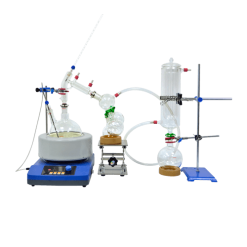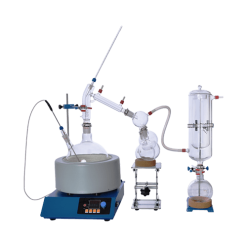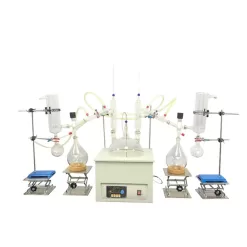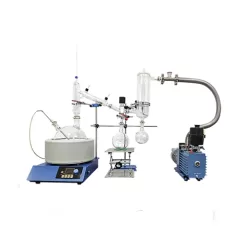
What is Short Path Distillation?
The short path distillation is a technique that removes solvents form mixtures through evaporation, which is mainly used for liquid-liquid separation. The principle is that the pressure difference between the boiling film and condensing surface is the driving force of the steam flow, and the minimum pressure will cause the flowing of steam. Under the 1mbar, the operation requires that there is the shortest distance between the boiling surface and condensing surface. The evaporator manufactured based on the principle is called the short-path distillation. The short-path distillation (molecular distillation) is equipped with a inside condenser which is opposite to the heating surface, and make the operation pressure reduce to under 0.001mbar. Its relative low boiling temperature is very suitable for the material with heat sensitive and high boiling point.
What is the Purpose of Short Path Distillation?
The short path distillation is one of the most high-efficiency distillation techniques in people’s using, which can solve the problem that conventional distillation technology can’t. It is very suitable for the extraction and concentration of heat-sensitive and high-boiling substances. It is widely used in food, medicine, fine chemicals, electronic materials, plastic engineering and polymers (such as polyols, fatty acids, polyphenols, polyurethane, epoxy resins, lactic acid, monoglycerides, flavors, heavy oils and paraffin oils) and other fields.
How to Do Short Path Distillation?
The short path distillation is a device used to separate solvents by evaporation. The whole short path distillation equipment works under vacuum for the whole time. So how to do short-path distillation?
- Sample should be placed in the glass reactor where heating mantle heats. Solvents get to evaporate by heating mantle’s working. And then the gas solvents will be transferred into the condensing part.
- Evaporated solvents will be turned into liquid from gas by condenser’s working. Condensing part consists of two parts, which are low temperature coolant circulation pump and condenser.
- After gas solvents are turned into liquid solvents, the liquid solvents will keep going and arriving at receiving flasks. There are always two receiving flasks. Different gas solvents with different cooling point will be turned into liquid under different temperatures, and then go into different receiving flasks.

Components of Short-Path Distillation
–Chiller: The term “chiller” can be miss-leading when talking about short path. A vapor can be recondensed at a temperature that is at least 20 degrees colder than what is was boiled off at. For example, a compound boiled off at 400F could be recondensed at 380F. The 380F temp is “colder” than the 400F that the compound boiled off at but, this is by no means actually cold. When doing short path distillation, the temp range will be about 100C to 250C (212F to 482F) on the heating mantle. This means the short path condenser will be set between 40C and 60C. We prefer 50C (122F) for a starting point (temp differentials regarding specific fractions will be discussed in an advanced post). This means we do not neccessarily need a “chiller”. We just need a device that will keep our desired 50C temperature during the process. This 50C temp will keep our short path from clogging and will be “cold” enough to easily recondense any vapors that travel into the path of the condenser.
–Vacuum Pump: When doing a distillation process, it is imperative that you have a chemically resistant vacuum pump that can acheive extreme depth. The pump should be able to achieve at least 50 micron but the deeper the better. The preferred type of pump for distillation is a rotary vane (oil) pump. Rotary vane pumps offer the best vacuum depth compared to other types of pumps (specialty pumps such as diffusion pumps will be discussed in a later post). Short path distillation can be very chemically abrasive to your vacuum pump. For this reason it is recommended to change your oil before every distillation. This will allow you the best depth and keep your vacuum pump running at peak performance.
–Cold Trap: The cold trap plays the important role of catching any vapors that pass through the condenser. This protects and prolongs the lifespan of your vacuum system.
–Short Path: The Short path itself is made up of 4 major glass components and the heating mantle. These components are: the boiling flask, the short path head, the receiving cow, and the receiving flasks. The heating mantle is similar to a heat bath on the rotovap. This is how you will heat the mixture inside the boiling flask. The head is the key to distillation. Inside the head there are small indentations called “vigreaux”. These create contact points for the vapors to bump as they travel up into the head. They create “theoretical plates” needed for distillation where vapors will become purified before entering the condenser path. The head also encompasses the condenser where the vapors will be pulled to re-condense into that beautiful golden color we all want to see. The three receiving flasks correspond to the three main fractions (single cows, swapable adapters, and head packing will be discussed in an advanced short path post).

Complete Short-Path Distillation Kit
01. Evaporation equipment
Evaporation equipment is the key part of the whole equipment. It is in charge of evaporating solvents, which is to extract solvents from liquid sample. In this part, there are two parts, which are heating mantle and evaporation flask. Heating mantle is to improve the evaporation flask’s temperature till solvents’ boiling point in order to extract it. The temperature of heating mantle is adjustable and users can adjust temperature through control panel.
02. Receiving equipment
There are two different receiving flasks here in the whole equipment. Because short path distillation is to separate two solvents, then it is necessary to set two different containers.
03. Condensing equipment
Liquid solvents are easier than gas solvents to collect. So there is condensing equipment working here to cool the gas solvents down. In this part, low temperature coolant circulation pump and condenser work together to cool gas solvents down.
04. Vacuum pump
In the whole process, the equipment works under vacuum at the whole time. Vacuum pump provides vacuum environment for the reacting equipment.
[title text=”Related Products” tag_name=”h2″ color=”rgba(32, 163, 219, 0.81)”]
[title text=”Related Posts” tag_name=”h2″ color=”rgba(32, 163, 219, 0.81)”]
https://www.rotovap.cn/short-path-distillation-kit/2908.html
https://www.rotovap.cn/short-path-distillation-kit/2999.html
https://www.rotovap.cn/short-path-distillation-kit/2971.html
https://www.rotovap.cn/rotary-evaporator/4365.html






